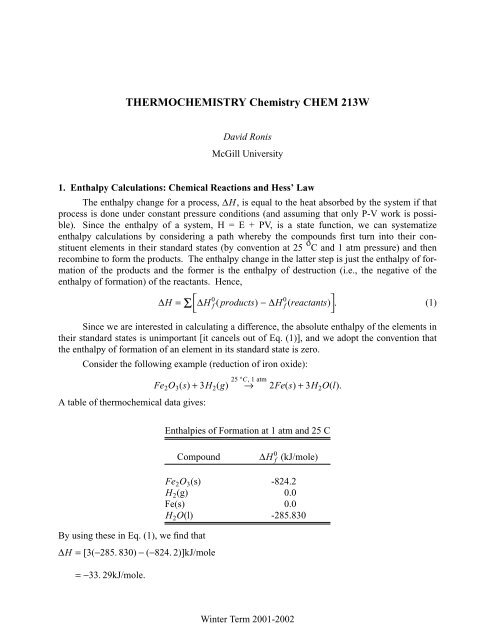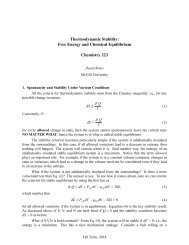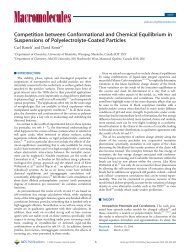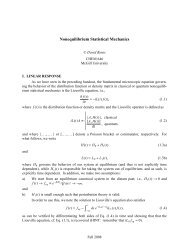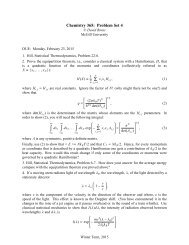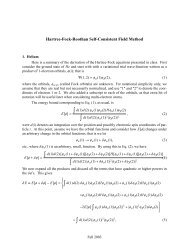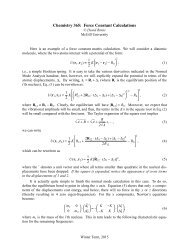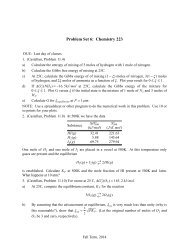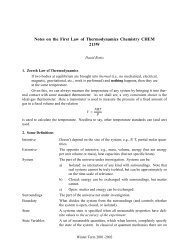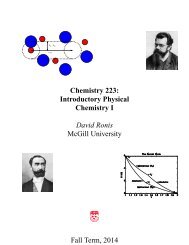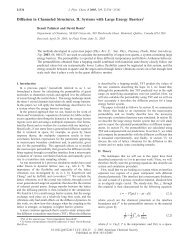THERMOCHEMISTRY Chemistry CHEM 213W - McGill University
THERMOCHEMISTRY Chemistry CHEM 213W - McGill University
THERMOCHEMISTRY Chemistry CHEM 213W - McGill University
Create successful ePaper yourself
Turn your PDF publications into a flip-book with our unique Google optimized e-Paper software.
Thermochemistry -4- <strong>Chemistry</strong> <strong>CHEM</strong> <strong>213W</strong>Constant Pressure Heat Capacities at 1 atm and 25 CCompoundC P (J/mole/K)Fe 2 O 3 (s) 103.8H 2 (g) 28.8Fe(s) 25.1H 2 O(l) 75.3Note that elements in their standard states do not have zero heat capacities. Using the data in thetable, and the result of our earlier calculation gives∆H rxn (358K) =−33. 29 +=−28. 1kJ/mole.[2(25. 1) + 3(75. 3) − 103. 8 − 3(28. 8)][358 − 298]1000Note that no change in phase occurred when we cooled (heated) the reactants (products).What changes would have to bemade if the reaction was carried out at 400 K?4. Bond EnergiesAuseful, albeit very approximate, way to calculate enthalpy changes in chemical reactionsis through the concept of bond energies. Consider the following reactionCH 4 → CH 3 + H;i.e., one C-H bond is broken. Experimentally, ∆H for this reaction is 102 kcal/mole. Similarly,∆H =96kcal/mole forC 2 H 6 → C 2 H 5 + H.Asurvey of such reactions will show that the heat required to break a single C-H bond is in therange 96-102 kcal/mole. We can thus assign 98 kcal/mole as an average bond energy for the C-Hbond. Similar tends are observed in the bond strength of other types of bonds, and the results aresummarized in the following tableWinter Term 2001-2002
Thermochemistry -7- <strong>Chemistry</strong> <strong>CHEM</strong> <strong>213W</strong>P 1P 2T 1P 1V1T2P 2 V 2Since, by assumption, Q=0,Porous PlugBy rearranging this expression we show thatFig. 1. The Joule-Thompson Experiment∆E = E(P 2 , V 2 ) − E(P 1 , V 1 ) =−W = P 1 V 1 − P 2 V 2 .E(P 1 , V 1 ) + P 1 V 1 = E(P 2 , V 2 ) + P 2 V 2 ;i.e., the enthalpy, H is constant in the Joule-Thompson expansion.In practice, large temperature changes can be obtained in this type of expansion (which canbe used in designing a refrigerator). The key parameter is the so-called Joule-Thompson coefficientµ JT ≡ ⎛ ∂T ⎞. (2)⎝ ∂P ⎠ H,NIn order to express µ JT in terms of more readily measurable quantities, note that⎛ ∂ f⎛ ∂y ⎞ ⎝ ∂x=−⎝ ∂x ⎠ f ⎛ ∂ f⎝ ∂ywhich is sometimes known as the "cyclic rule" or "implicit function differentiation." It is provedby noting thatdf = ⎛ ∂ f ⎞dx + ⎛ ⎝ ∂x ⎠ y⎝setting df=0, and by solving for the ratio dy/dx.µ JT =−By using the cyclic rule on Eq. (2), we find that⎞⎠ y,⎞⎠ x∂ f∂y⎞⎠ xdy,⎛ ∂H ⎞⎝ ∂P ⎠ T ,N⎛ ∂H ⎞⎝ ∂T ⎠ P,NWinter Term 2001-2002
Thermochemistry -8- <strong>Chemistry</strong> <strong>CHEM</strong> <strong>213W</strong>=− 1 ⎛ ∂H ⎞C P ⎝ ∂P ⎠ N,T=− V ⎧⎨⎩ 1 − ⎡ β ⎢P + ⎛ ∂E ⎞ ⎤⎫ C P ⎝ ⎣∂V ⎠ ⎥⎦ ⎬⎭N,T=− V C P⎡⎣1 − βαV (C P − C V ) ⎤ ⎦ =− V C p[1 − α T ],where the second to last equality follows when the definition of the enthalpy interms of theenergy is used and the manipulations used in calculating C P − C V are repeated. β is the isothermalcompressibility. Note that the Joule-Thompson coefficient vanishes for an ideal-gas.Winter Term 2001-2002


